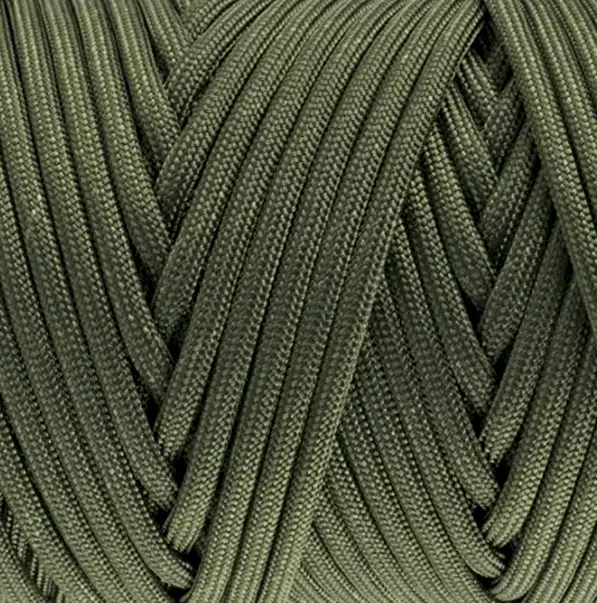There are so many questions about paracord and it’s easy to understand considering that this is such a versatile and useful survival material. One of the most frequent questions I see after whether or not paracord will stretch is whether or not paracord will shrink if you expose it to water.
There does seem to be some confusion on this question, and it’s important to clear it up so you know what the paracord can and can’t be used for and how you can expect it to react. The good news is that there is a definitive answer when it comes to paracord, water, and how it is going to react.
Paracord will shrink 2-12% with 5-7% shrinkage the average the first time that it gets wet. This shrinkage occurs after the soaked paracord dries out. After that first exposure the paracord should not shrink again no matter how many times it is re-exposed to water.
Getting paracord wet isn’t a problem and the shrinkage isn’t anything major. In fact if you’re not paying attention it could be easy to miss just how little size is actually lost as a result of the water exposure assuming you have higher quality paracord or take my advice and soak any paracord you’re going to use for crafting prior to the actual crafting itself.

Should You Pre-Shrink Paracord?
This is an excellent question, and I would recommend any paracord used for crafting or taking out for survival kit purposes should be exposed to water and pre-shrunk to avoid bigger problems later. When using paracord it’s best to pre-shrink it using hot water and then let the nylon dry out completely. This should be done before tying knots, creating a survival bracelet, or creating any other paracord based outdoor or survival tool.
Once fully dried the paracord is at the size that it will remain and this works out extremely well before making a paracord survival bracelet, any type of craft, or otherwise using it for flexible lashings of any kind.
This is highly recommended because if you make a survival bracelet out of paracord that fits your wrist, and then it shrinks 10%, that can actually be enough to cause undue stress and make the fit worse than it would otherwise be. Paracord is flexible and fairly resilient at 550 and above, but why take the chance of having anything you create shrink on you?
Make sure the fit you like is the one that’s going to remain – pre-shrink any paracord before using. Even if the package claims it’s pre-shrunk, it never hurts to test it out and confirm whether this is the case or not.
Are Paracord Bracelets Waterproof?
After the initial exposure to being soaked in water, and then being fully dried off, paracord bracelets are waterproof after that point. Assuming the paracord bracelets were made correctly and the paracord was treated in water before the bracelet was made, it will be waterproof. If it was not, then it will shrink after drying out from water exposure, likely 5-7% but it can be a bit more or a bit less depending on a variety of factors including quality.
Important Note: Be careful with scummy pond or stagnant lake water. If the paracord is soaked in water that smells, that smell needs to be thoroughly washed out in fresh water or it will stick around. Not pleasant.
You should look to see if paracords are advertised as waterproof or not, but keep in mind since minor shrinkage only happens once, it’s fully possible that the cord wasn’t properly treated so it can be a good idea to test it out in the kitchen before taking it out into real world conditions.
If you are making your own paracord bracelets simply pre-treat the paracord by soaking it in water and then drying it out thoroughly before crafting your bracelet. If you do that you’ll know for sure that the paracord you’re working with won’t shrink and your bracelet will be waterproof as a result.
Does Paracord Get Moldy When Exposed To Water?
No. Nylon doesn’t mold easily and paracord is built to be used in all weather conditions, so it’s designed to be mold resistant. That’s not to say a piece of paracord hanging off a log in a rainy forest for months on end wouldn’t gain a mildew smell or rot over time, but for all intents and purposes you can assume that paracord is mold proof where it matters.
Normal or regular water exposure should not cause mold or mildew issues with your paracord. It should dry out without any problems and remain solid overtime. Because of the materials that paracord is made of it actually is much less inclined to mold than old fashioned rope or string made from more natural materials.
Does Rain Vs Submerged Matter for Paracord?
If you’ve been in the outdoor space long enough, you’ve run into the issue of “water resistant” where something claims to be great in wet climates, but submerge it once and all hell breaks loose. So is paracord “waterproof” where it’s good in rain but not while fording a creek, or is it actually waterproof? If you are using normal nylon paracord, the paracord should be 100% waterproof after initial content.
Paracord & Waterproofing: Some Final Thoughts
While I’m not necessarily as bullish on paracord as some other survivalists and outdoor fanatics, this is a versatile and useful item to use for a variety of potential outdoor situations or scenarios. By pre-treating bundles of paracord at home by soaking it in a kitchen sink then drying it out completely, you can rest assured that all shrinkage has occurred and your properly treated paracord will not shrink again!
Other Outdoor Articles of Interest
